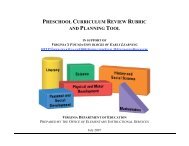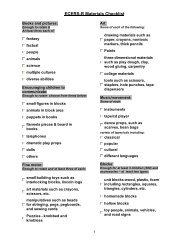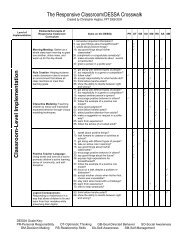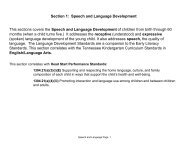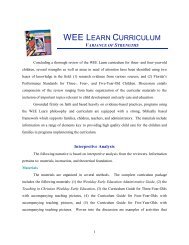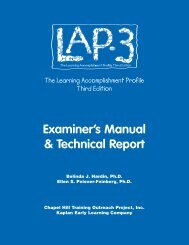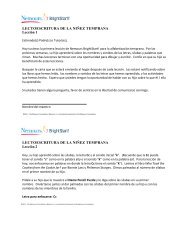Examiner's Manual & Technical Report - Kaplanco.com
Examiner's Manual & Technical Report - Kaplanco.com
Examiner's Manual & Technical Report - Kaplanco.com
- No tags were found...
You also want an ePaper? Increase the reach of your titles
YUMPU automatically turns print PDFs into web optimized ePapers that Google loves.
Parents were asked to indicate the highest education level <strong>com</strong>pleted. Table 8 shows thedistribution of highest education level <strong>com</strong>pleted for mothers and fathers separately for eachlanguage group and the total project sample. This distribution is consistent with U.S. Censusreports (2000), which indicate lower literacy and high school <strong>com</strong>pletion rates among the Latinopopulation than among African-American and White populations.Table 8. Highest Grade Completed of Mothers and Fathers by Language for Project Sample (n=2099)English Sample 1 Spanish Sample 2 Total Project SampleMother Father Mother Father Mother FatherHighest Grade n % n % n % n % n % N %< High school 0113 010.1 0098 008.7 391 34.8 346 035.5 504 24.0 444 21.2High school 0369 032.8 0356 031.7 278 24.7 251 025.7 647 30.8 607 28.9AssociatesdegreeBachelorsdegree0191 017.0 0133 011.8 087 7.7 079 008.1 278 13.2 212 10.10242 021.5 0207 018.4 043 3.8 028 02.9 285 13.6 235 11.2Masters degree 0103 009.2 0076 006.8 010 0.9 012 01.2 113 5.4 88 4.2Doctoral degree 0012 001.1 0018 001.6 002 000.2 003 000.3 14 0.7 21 1.0Not reported 0094 008.4 0236 021.0 0164 14.6 256 026.3 258 12.3 492 23.4Total 1124 100.0 1124 100.0 975 100.0 975 100.0 2099 100.0 2099 100.01 The 2000 US Census reports the following percentages for highest education level <strong>com</strong>pleted for all races/ethnicities: less than high school, 10.5%; high schooldiploma/GED, 31.8%; Associates degree, 7.7%; Bachelors degree, 16.4%; Masters degree, 5.5%; Doctoral degree, 1.0%. (Additional categories include: Somecollege/no degree, 19.2%; Professional degree, 1.3%.)2 For Hispanics and Latinos of any races, the populations percentages were as follows: less than high school, 42.7%; high school diploma/GED, 28.4%; Associatesdegree, 4.8%; Bachelors degree, 7.0%; Masters degree, 1.6%; Doctoral degree, 0.3%. (Additional categories include: Some college/no degree, 14.6%; Professionaldegree, 0.6%.)Program TypesChildren were recruited from a variety of different settings. The primary types of settings were:center-based child care programs (n = 65, 50.0%), including developmental day, day care, andpreschool programs; Head Start programs (n = 24, 18.5%); private schools (n = 19, 14.6%);public schools (n = 12, 9.2%); and other settings such as WIC (n=10, 7.7%). A total of 130programs/schools participated in the study, with some variation in the types of settings across thefour geographic regions. For example, the Northeast site included a Head Start program, twocenter-based facilities, and one public school system. In the South, three <strong>com</strong>munity child carecenters, nine Head Start programs, 17 private schools, and one public school system participatedin the study. The participants in the Central site included 11 center-based programs, eight HeadStart programs, six public schools, and two private schools. The Southwestern site was<strong>com</strong>posed of 22 center-based programs, eight Head Start programs, and four public schools. TheWIC and other miscellaneous types of settings were spread across the four geographic regions.MeasuresThis section describes the various measures used in the standardization study of the LAP-D.49




